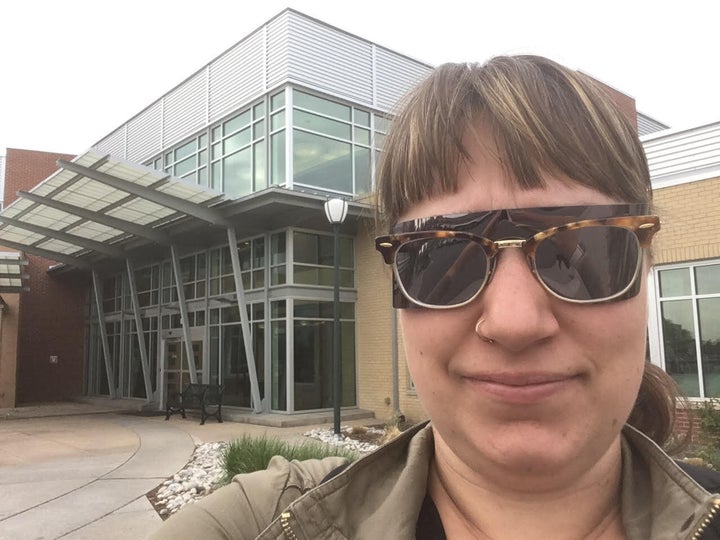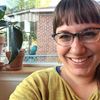
Growing up in suburban Maryland, I was accustomed to the ritual eye exam, where an optometrist shone a red pinprick of light into my pupils, flipped lenses in a metal mask and declared me near-sighted like my parents. I never had any health emergencies to speak of, save for the early removal of my tonsils at age 4. My health checkups bored my physician; my childbirths were thankfully normal; I never even had a cavity.
I had no reason to learn about the specialized organs of the eye — the lens, iris, pupil and cornea at the front, the vitreous gel in the middle, and the retina and optic nerve at the back. Nor did I know the word “macula,” the very center of the retina, where a lesion would soon obstruct the sight in my right eye.
But one day after Christmas 2016 when I was 29, I noticed something off with my vision. If I closed my left eye, then everything in the center of my right eye’s view would disappear. I could still see around the obstruction; my peripheral vision remained the same as always. With both eyes open, the cloud appeared like a bead of sweat on my glasses.
For a whole week, I stared at the ceiling as I fell asleep, testing and retesting, opening and closing my eyelids. I was imagining it. Right? After all, who in the hell loses their vision at age 29? Fear choked me. I could not find the words to describe what was happening.
I thought speaking the words out loud ― something is wrong with my eye ― might make them real, might make them flower and fruit. It was irrational. I had brought about nothing through sheer thought power except panic attacks.
“I never had any health emergencies to speak of. ... My health checkups bored my physician; my childbirths were thankfully normal; I never even had a cavity.”
But with my left lid shut, I could no longer read the text on the pages of my Bible. I could not discern street signs. I could not make out the green of my own iris in a mirror, nor my daughter Hope’s ring of yellow circling her blue eyes, nor the growing number of teeth emerging from my son Zeke’s gums like shoots from the thawing spring dirt. Wherever I looked, the cloud remained.
After seven days of silent suffering, I told my husband, the most reasonable man in the universe. “There’s a hole in my vision,” I said. “Make an appointment,” Jeremy said. So I scheduled the appointment for the first week of February.
As it turned out, I had developed a rare retinal disease, so rare that at first, no one could tell me its name. A cloud had painlessly appeared at the center of my right eye. My left eye remained the same as it always had, giving me whole, clear ― albeit near-sighted ― images.
At that initial appointment, my retina stumped the optometrist. Two weeks later, I entered a specialist’s office and submitted to a series of high-tech tests: Microscopes photographed the back of my eye, red dye ran through my veins to illuminate the vascular tendrils at the back of my eye, and I squinted across a room to read letter charts. My right eye failed spectacularly.
When the specialist met me in the exam room, he proclaimed my retina “ratty.” I blinked, stunned by the word. But after studying the photo, I agreed: My right retina looked a muddy mess. A lesion in the back of my eye had irreparably damaged its center. Worse, the specialist had no diagnosis, though he could tell me what it wasn’t: not cancer, not trapped fluid, not genetic (good news for my two kids), and at that moment, not an active infection.
I said, “But you can fix it, right? You can fix a broken retina, can’t you?” Perhaps I recalled news of miraculous transplants. Or perhaps I held that faith in medicine that the young alone can feel. However, on that Tuesday in February 2017, the specialist shook his head. He said, “I’m so sorry.”
Since then, I have had to learn all about the eye. I’ve learned that the macula houses the greatest density of rods and cones — the light-sensitive cells. The macula lets me see details and colors, read the words on my computer screen, remove a splinter from my crying toddler’s finger or study the stamen of a flower. I have now learned that the macula is irreplaceable.
“When the specialist met me in the exam room, he proclaimed my retina ‘ratty.’ I blinked, stunned by the word.”
I languished without a diagnosis for three days. During every one of those days, I wept, shook with anxiety and convinced myself that the growth in my eyeball was actually cancer. (Though the specialist had assured me that I did not have anything like cancer, I had no other way to explain an unidentified lesion.) All this felt above my pay grade as a freelance writer, lead parent of two toddlers and wife in the suburbs of Denver.
However, I couldn’t call in sick for my anxiety. I spent my days feigning normalcy: pulling shirts over heads, wiping bottoms, frying eggs, buttoning coats, waving goodbyes, chopping vegetables, washing dishes, bandaging owies, riding stationary bicycles in nylon pants, penning the pages of my journal, scrolling through websites, shoveling pints of ice cream into my mouth and taking deep breaths in the bathroom when no one was looking. I hoped following my normal routine would help me escape the panic that had settled into my chest.
The doctor called on Friday. Eggs sizzled in a pan for breakfast as my phone buzzed in my pocket. We had a diagnosis. I scribbled the words on the back of an envelope, hunched over our kitchen island, my kids still in their pajamas, my husband waiting to hear the news with a mug of coffee in his hands.
I had unilateral acute idiopathic maculopathy or UAIM. The doctor explained: “Unilateral” meant in one eye; “acute” meant sudden onset; “idiopathic” meant not related to any other bodily illness, but a singular symptom; and “maculopathy” meant affecting the macula. The doctor said the lesion might still go away on its own, the infection having waned by now.
Relief flooded. And then doubt followed, and anxiety, and then the whole spectrum of bold-colored emotions. I carried tissues in my pocket, in case of the tears that could strike at any moment. My husband became accustomed to cooking dinner on the days when I could not stop crying. Because the diagnosis did not change anything, not really. I was still losing vision.
“The doctor said the lesion might still go away on its own, the infection having waned by now. Relief flooded. And then doubt followed, and anxiety, and then the whole spectrum of bold-colored emotions.”
My husband, kids and I managed on our own, with the help of a therapist, phone calls from faraway friends, and our enthusiastic church community, who delivered tubs of soup when we asked for help. Meanwhile, my grandmother left messages in my voicemail, terrified the doctors had gotten my diagnosis wrong and begging me to make up with my parents, whom I had cut out of my life months earlier due to our unresolved dysfunction. I realized my catastrophizing had also been inherited, along with excellent genes.
I had only bad news to pass along to her. Over time, the lesion did not disappear; it swelled. Over the next three, six, nine months, the lesion grew and shrunk, grew and shrunk again, and whenever it returned, the veins in my retina hemorrhaged and scarred my retina further, leaving behind permanent static in my vision.
After one year of agonizing appointments and expensive exams and emergency after-hours calls to the specialist, I begged him for a prognosis ― just tell me my future, please, anything. He said, “We’re only in the third inning. We have no idea how the game will end.”
So then I fixated on “healing,” the belief that the supernatural can restore faulty bodies like mine. As a Christian, the way I sought this healing was to pray. A lot. I also asked others to pray. During that time, my specialist had a brainwave: He gave me shots of a miracle drug in my right eyeball. While the shots did not restore what I had lost, they did slow the decay of vision in my right eye, a kind of incomplete healing.
Yet many prayers went unanswered. In their wake, now three years into this illness, I am learning to live half-blinded. I’m now called “low-sighted,” the description that matters more than an obscure diagnosis. I am “legally blind” in my right eye, meaning my vision is bad enough to decipher only the large “E” on the eye chart. Or said another way, what someone with normative vision could read from 200 feet, I can read from 20 feet.
“Many prayers went unanswered. In their wake, now three years into this illness, I am learning to live half-blinded. ... What someone with normative vision could read from 200 feet, I can read from 20 feet.”
I trip on Lego blocks hidden in the carpet. I slam into the edges of coffee tables. I dice garlic with blaring under-cabinet lighting (and stock the kitchen drawers with bandages). Early on, I would notice new limitations every day. The volume of tasks hindered by my eye overwhelmed me. One night I broke down in front of my husband as my plate of food went cold, equally furious and tearful. He frowned and asked how he could help me. What if he took over laundry duty or cooked our breakfasts?
I sighed. I did not want his help, thank you very much. What I wanted was to have my vision back, to have my old life, my old body. Back to normal. He said, “It sounds like you’re grieving, Liz.”
Though I rolled my eyes and wanted to scream at his words, he was right. He saw what I couldn’t ― the first step to accepting my new normal was grief.
After recognizing every little symptom and then experiencing every limitation came an obsession to answer the question why. Why had this happened to me? If I could find a person to blame, even better. Had my parents passed down faulty genes? Did the stress of being a mother lower my immune system? Was God punishing me? Or was the fault mine somehow?
But nothing brought the answers — or the healing — I longed for. Not expressing my every feeling — the rage, the tears, the catastrophizing. Not a Whole30 diet. And certainly not extra workouts, Zoloft, essential oils, meditation, therapy or CBD. While shots of the miracle drug have stabilized my disease for the time being, they have not restored vision.
For three years now, I have lived with this retinal disease. The microscopic lesion remains. Eighty percent of the central vision in my right eye is gone so that all I see is a gray static with a pinprick of distorted light at the very center, as if looking through the surface of water.
I have finally decided that no one is at fault, not even me. I’ve lost the invincibility of youth. I now understand that my field of sight will likely shrink further as I age. But I also understand that a failing body does not make me a failure; it makes me human. I make do and I will keep making do. There will be tears, doubt and fear, but I have people who will gather around and help me make it through. And we will make do — together.
Have a compelling first-person story or experience you want to share? Send your story description to pitch@huffpost.com.
